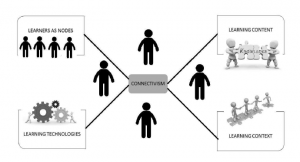Connectivism

With the more advanced developments in Internet technology, a more recent conceptualisation of learning has been developed. Siemens (2005) underlines the limitations of behaviorism, cognitivism and constructivism in that they only capture the learning that occurs inside learners and do not address the learning that takes place between them. He proposed a new learning theory, “connectivism”, and dubbed it the “learning theory of the digital age”. Theoretically, connectivism focuses on connecting specialised sets of information together and the connections that allow people to learn are more important than what they know currently (Siemens, 2005). Under connectivism, learners construct their knowledge by connecting with content and other learners through the use of social media, blogs and Wikis. In other words, connectivism encourages learners to connect with one another in order to create and share knowledge through social media. Therefore, the primary objective of connectivist learning is not learning particular content, but rather constructing knowledge through having interaction and dialogue with other learners, both socially and mutually (Lane, 2012).
According to Siemens (2005), connectivism provides a guide for any online learning environment, especially MOOC courses. The first MOOC “Connectivism and Connective Knowledge” was based on connectivism theory. This first MOOC adopted learner-centred pedagogy and expected participants to learn with and from one another.




